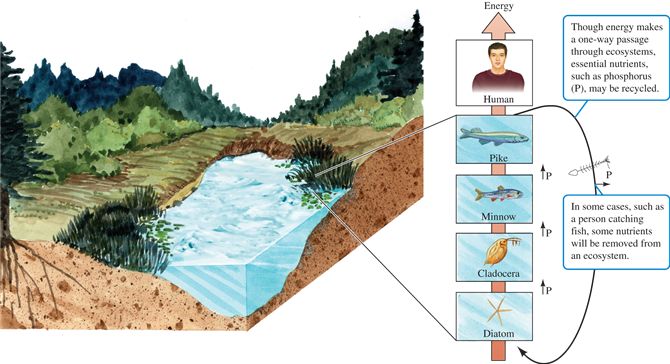 |
| Previous Image | Next Image |
| Description: Exchanges of nutrients between organisms and their environment is one of the essential functions of an ecosystem. A diatom living in the surface waters of a lake absorbs an ion of phosphate from the surrounding water. It incorporates the phosphate into some of its DNA as it replicates its chromosomes during cell division. A few hours later, one of the diatom's daughter cells is eaten by a cladoceran, an algae-feeding member of the zooplankton. The cladoceran incorporates the phosphate into a molecule of ATP. The cladoceran lives two days more and then is eaten by a planktivorous minnow. Within the minnow, the phosphate is combined with a lipid to form a phospholipid molecule in the cell membrane of one of the minnow's neural cells. A few weeks later, the minnow is eaten by a northern pike and the phosphate is incorporated into part of the pike's skeleton. During the following winter, the pike is caught by an intrepid person dropping a hook through the ice. The fish is filleted on site, with the tasty fillets packed for home. The offal and skeleton are not kept, and instead are dropped back down the fishing hole. These tissues are attacked by bacteria and fungi that gradually decompose the remains of the pike. During decomposition, the phosphate in the skeleton is dissolved in the surrounding water. The following spring the very same ion of phosphate is taken up by another diatom, completing its cycle through the lake ecosystem (fig. 20.1).
Picture Stats: Views: 4583 Filesize: 53.5kB Height: 364 Width: 670 Source: https://biology-forums.com/index.php?action=gallery;sa=view;id=2037 |
